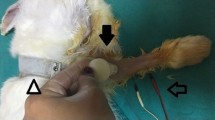Summary
Methods in current practice for ascertaining time of death are largely based on the cooling of the body after death and are somewhat unreliable. A theoretica relationship is known to exist between the decline in the properties defining nerve conduction and time after death caused by the gradual cessation of metabolic activity in nerves. A number of such properties were measured in rats during life and after death. In most cases the relationship was found to be inconsistent. The chronaxie of the strength duration curve for the sciatic nerve was, however, found to increase consistently and reproducibly in a linear fashion over the first 90 min after death to a plateau value which was maintained beyond 135 min. These findings are discussed as the possible basis of a forensic method of determining the duration of the “post mortem interval” within the first few hours after death.
Zusammenfassung
Die in der Praxis angewandten Methoden zur Bestimmung der Todeszeit basieren hauptsächlich auf der Abkühlung des Körpers nach dem Tod und sind nicht immer ausreichend zuverlässig. Eine theoretische Beziehung zwischen dem Absinken der Nervenleitfähigkeit und der Dauer des postmortalen Intervalls ist bekannt. Die Veränderung der Leitfähigkeit ist dabei durch das allmähliche Erlöschen der Stoffwechselaktivitäten bedingt. Einige für die Nervenleitfähigkeit bedeutsamen Parameter wurden an lebenden und verstorbenen Ratten gemessen. Die meisten dieser erlaubten jedoch keine eindeutige Aussage. Aus der Reizzeit-Spannungs-Kurve des nervus ischiaticus wurde die Chronaxie bestimmt. Sie stieg während der ersten 90 Minuten im Tod ständig und reproduzierbar in linearer Form an, um dann in ein Plateau überzugehen. Diese Ergebnisse werden als Basis eines Modells zur Bestimmung der Todeszeit im früh-postmortalen Intervall diskutiert.
Similar content being viewed by others
References
DiMaio DJ, DiMaio VJM (1989) Forensic Pathology. Elsevier, New York, pp 21–42
Glasby MA (1991) Interposed muscle grafts in nerve repair in the hand. An experimental basis for future clinical use. World J Surg 15:501–510
Glasby MA, Gattuso JM, Huang CL-H (1988) Recovery of peripheral nerves after surgical repair with muscle grafts. (1) Physiological assessment. Neuro-orthopedics 5:59–66
Hodgkin AL (1964) The conduction of the nervous impulse. Charles C. Thomas, Springfield IL
Hodgkin AL, Huxley AF (1952) A quantitative description of membrane current and its application to conduction and excitation in nerve. J Physiol 117:500
Hutchins GM (1985) Body temperature is elevated in the early post-mortem period. Hum Pathol 16:560–561
Knight B (1982) Legal aspects of medical practice, 3rd edn. Churchill Livingstone, Edinburgh London Melbourne New York, p 122
Lapique L (1926) L'excitabilitie en Fonction du Temps. Press Universitaires de France, Paris
Mason JK (1983) Forensic Medicine For Lawyers, 2nd edn. Butterworth, Edinburgh
Spitz WW, Fisher RS (1980) Medicolegal Investigation of Death. 2nd edn. Charles C. Thomas, Springfield IL
Sturner WO, Gantner GE (1964) The post-mortem interval; a study of potassium in the vitreous humor. Am J Clin Pathol 42:134–144
Author information
Authors and Affiliations
Rights and permissions
About this article
Cite this article
Straton, K.J., Busuttil, A. & Glasby, M.A. Nerve conduction as a means of estimating early post-mortem interval. Int J Leg Med 105, 69–74 (1992). https://doi.org/10.1007/BF02340826
Received:
Revised:
Issue Date:
DOI: https://doi.org/10.1007/BF02340826




